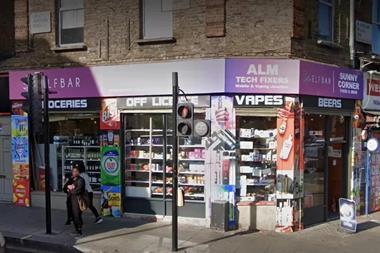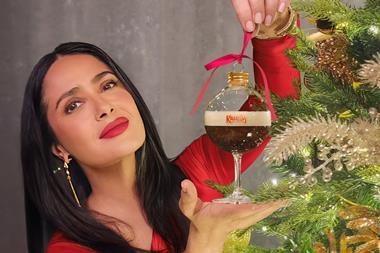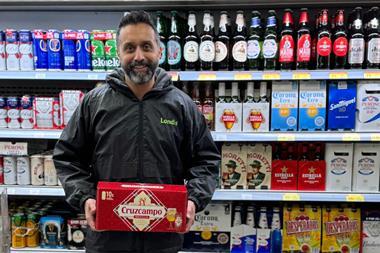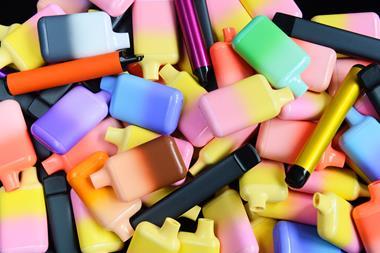Cider is fast becoming the one of the hippest brews on the c-store shelf, with vintage, local and new flavours adding the category’s appeal
As summer (hopefully) starts to heat up, more sun-seeking shoppers will be searching out cider to accompany everything from back-garden barbecues to outdoor music festivals.
And the good news is that when thirst strikes, they’re likely to swing by your store to pick it up.
The stats show that apple-based alcohol and c-stores go together like a pint of cider and a packet of crisps. According to Westons Cider Report 2017, overall cider sales have increased 2.1% to reach £2.88bn – and much of that growth is happening in convenience.
Today c-stores represents 48.4% of total cider sales, almost matching the action in the mults. That means this summer canny retailers have the chance to be the first choice for more of the 11.1 shopping trips for cider that the average household makes every year.
Not bad for a category that was once more associated with novelty pop acts (‘I am a Cider Drinker’ by The Wurzels, anyone?) than big sales.
So how can retailers get the cider category right in-store? Avtar Sidhu from Sukhi’s Simply Fresh in Kenilworth, Warwickshire, confirms that the time to get behind cider is when the sun comes out and the temperature rises.
“I’d say that cider is probably one of the more seasonal products within alcohol as a whole,” he explains. “You’re probably going to get 70% of your sales within that spring/summer period as that’s when the weather is nicer and people tend to switch from other alcohol and beverages into cider.”
Avtar believes that it’s important to cater for these “summer switchers” by offering a good range of mainstream choices from the large cider brands.
Strongbow, Merrydown and the like have always been solid c-store sellers, but the recent rise of more niche competitors has helped add excitement to the category. It has also inspired customers to look beyond the big boys on the block towards local tastes and flavours.
With this in mind, Avtar slakes discerning customers’ thirsts with a range of local and organic ciders, including a brand that rejoices in the name Wobblejuice, from Clive’s Fruit Farm.
“Wobblejuice comes from a local fruit farm just down the road, so there’s that local link straight away which appeals to people when they come in,” he says.
“It’s a bit different because the manufacturing and production techniques are a world away from larger names – it’s going to be hand-produced. This means there’s a taste difference, too.
“I’m not a big cider fan (I don’t drink a lot of alcohol anyway), but if I want cider I’d much rather go for the local option.”
The right price
Naturally, small-batch production methods are going to mean a higher price point on the shelves. This alone is enough to put some retailers off (C-Store spoke to one retailer who had tried to experiment with local cider – but “couldn’t get it to work” at the right price for his shoppers). However, Avtar maintains that with quality and provenance-conscious consumers, and a proactive approach on the shop floor, stores can leverage the appeal of local.
“You can’t just throw [local cider] in with the rest [of your alcohol offer] and hope it sells. You’ve got to be able to tell the story behind the manufacturer, and put across the credentials to customers – the fact that the product’s authentic,” he says.
“We try to put all our local stuff – your craft ales, local ales or ciders – together in the same spot. Put a bit of POS down there and it stands out and it’s highlighted on the shop floor.
“It isn’t going to be for everybody, but what it does is offer that point of difference. If you stick with it, what you find is the loyalty of the consumers who buy into the product is very, very high.
“Customers will switch their loyalty between a lot of other brands quite quickly, but with products such as Wobblejuice we’ve got a regular hardcore following and they will come in and buy in volume. They’ll have eight, 10 or 12 at a time.”
Paul Mather, of Sherston Post Office Stores in Wiltshire, has just taken delivery of 3ltr bags of cider from local producer The Original Cider Company in Somerset. He’s selling three variants to start with – a pear and two strengths of apple and they retail at £5.79. He’s hoping for some sunshine to really get sales moving.
“It’s very early days, but I’m expecting great things; it’s summer, they’re from an independent cider farm and hopefully we’ve got the pricing right. Initial feedback has been good.
“I think it offers a point of difference, especially as they are high quality.”
He says the biggest challenge is making sure customers know he is selling the ciders. “We’ve got some POS coming from the farm, but we have a great artist whom we use to create POS for us that’s really good.
“We also use social media a lot, and when it’s a warm day we’ll make a big thing about the ciders and put them behind the counter. We’ll choose our time as cider is very weather dependent.”
Authentic flavour
These days, though, if local isn’t right for you, then that’s no barrier to going upmarket. A quick trip to the cash and carry is all you need to stock up on brands that have an appealing back-story and an authentic feel.
And with vintage fashion coming back in a big way, it’s no surprise to see that vintage ciders (such as Henry Westons and Thatchers) are all the rage with suppliers.
Richard Inglis, from Parkview Retail in Southampton, says that this artisan approach has helped create a focal point in his three Welcome Co-op stores’ chillers, and is driving interest with shoppers.
“Cider has definitely grown in importance over the past couple of years,” he says. “What people seem to like is the trendy, slightly rustic feel that you get from brands such as Kopparberg when you pick up the bottle. It’s like a ‘real ale’ approach.
“The brand and marketing suggests it’s been around for a while – that there’s a history behind it. People like that and definitely buy into it at our stores.”
Richard explains that in his stores about a third of each alcohol chiller is dedicated to something different, with cider taking up its own section. The wide selection he stocks reflects how diverse the category is getting.“It’s not like we just have one solid shelf of Kopparberg, it’s about having a selection of different brands,” he says.
“We’ve got the Old Mout range in, we’ve got the Kopparberg range in, we’ve got the Strongbow range in, and Westons, which does really well for us. It’s not like the customer comes in and sees just two shelves of cider block-filled. When you look at our ciders they’re all facing on the shelf so they look good, and that pays off – we do see sales spread across the whole range.
“Interestingly, a lot of alcohol isn’t necessarily special offer-driven anymore, at least not here. Gone are the days when you could sell a load of wines at three for £10! It’s not quite that market any more – it’s definitely changed.”
Craft ciders
Over at Harj Dhasee’s Nisa Village Store in Mickleton, Gloucestershire, the craft end of the spectrum is certainly driving sales. “It’s the craft stuff that’s absolutely flying out at the moment,” he says.
“I think that people are exploring different drinks, so they’re looking at the craft beer category and getting something similar in cider. I reckon that customers are probably drinking less today, but what they want to drink is quality rather than quantity.”
Where his retail experience differs from Richard is on the subject of promotional offers. When summer comes round he makes sure he puts the cider category on a permanent “three for five” deal, which he says “has really driven volume through the roof”.
Harj adds that craft cider sales are weighted towards the older customers, who probably have a little bit more money to spend.
With this in mind, what are the under-25s choosing when they dip into the cider chiller? The answer is a category that has revolutionised the cider market over the past five years: fruit cider. Pedants may point out that cider has always been derived from fruit (usually apples or pears), but their voices have been drowned out by younger consumers looking for flavoured cider that is a bit less fizzy, sweeter and easy to drink.
Traditional cider diehards shouldn’t scoff, though. The rise of flavours such as strawberry, passion-fruit and mango has helped turn cider from an old-fashioned option into a trendy c-store choice. Currently, fruit cider is enjoying an impressive 32% growth year on year (Westons Cider Report 2017) and is definitely a popular product among retailers.
“The flavoured ciders are definitely coming into their own now. As summer arrives we flex our space to bring in more flavoured lines,” says Harj.
“In the past it used to be just your standard apple ciders and that was it,” confirms Richard. “Today everything from Strongbow to Kopparberg to your Old Mout flavoured ciders are definitely big growers. I would even say, in fact, that the market has moved away from alcopop-type stuff into fruit cider. Fruit flavours are certainly a huge chunk of sales.
“Kopparberg is our strongest-selling variety of flavoured cider. And you’ve also got Strongbow Dark Fruit – which I think is the modern equivalent of the ‘cider and black’ you used to get in the pub when you were younger.”
Fruit cider goes down so well that Richard reckons he’d ditch some of the more traditional apple lines if space became an issue.
“To give you an idea, our Old Mout kiwi lime cider sold 25 bottles the previous week and we sold six cans of a standard cider. That’s quite a contrast, isn’t it?” he says.
“Fruit cider has changed the market completely. Shoppers want something interesting and different, and that’s driving the trend for flavours.”
The future
With vintage and fruit products leading the way, sales of cider might be going great guns in c-stores, but the manufacturers are now facing a big challenge for the future. A period of what Mintel calls “phenomenal” growth has slowed as the market becomes saturated with brands all trying to out-do each other.
It suggests the answer is to continue the path upmarket by using new opportunities to tell shoppers about a product’s heritage and provenance on the shelf. This could mean, like craft beer, cider becomes more of a ‘foodie’ product to rival wine. Beer and food pairings are now in the mainstream, so is there now space for cider to get in on the dinner party act?
Martin Thatcher, fourth generation cidermaker at Thatchers Cider, certainly thinks so. “Offering new ideas and promoting the versatility of cider is a great way for retailers to add interest to their merchandising. We’ve come up with some wonderful cider cocktails, which are really on trend. We’ve also produced a Guide to Pairing Cider with Food, which explains which styles of cider go well with different food types, helping retailers come up with cider and food pairing recommendations for customers. This works particularly well during the outdoor party and barbecue season when there are plenty of opportunities for cross-merchandising.”
This new foodie focus on cider certainly hasn’t been lost on Richard. A fair proportion of his cider stock goes to fuel student parties (“You look at the figures and say ‘yep – there was a party on that Tuesday,” he laughs). But he’s also noticed young professionals buying it as an on-trend choice for other less-raucous social occasions.
“I think it’s probably very 1980s to say that everyone goes along and takes a bottle of white wine to a party these days,” he says.
“I think cider is becoming a bit of a substitute to traditional wines as they used to be. People can take a bottle of cider along to an event as opposed to having to have a six-pack of lager or bottle of wine.
“I think it just opens the market up a little bit more. People these days are more adventurous than they used to be.”




























No comments yet